by B.B. Pelletier
I’m posting a Best of BB today because I had cataract surgery yesterday and I couldn’t see the computer screen to write. I selected this article from December 30, 2011 because it’s the last of 11 experiments I( did on spring gun accuracy and pellet velocity. We seem to be interested in tuning spring guns, and this is a good one to read. Remember — there are a total of 11 parts. So enjoy!
I see it seems to indicate there will be another part to come at the end of this report, but I never wrote it. This is the last in the series.
Part 1
Part 2
Part 3
Part 4
Part 5
Part 6
Part 7
Part 8
Part 9
Part 10
Happy New Year from Tom & Edith!
One nice thing about watching a TV program is that it only takes an hour or less to view. You have no sense of the man-weeks of work that go into a short production on screen. Sometimes, the same thing happens in the world of airgun blogs.
I won’t say I’ve been dreading today’s report; but from past experience adjusting the HOTS on the Whiscombe rifle, I knew it might take longer than anyone could imagine to get a good result. It’s easy to say, “Adjust the HOTS for optimum performance with a certain pellet.” Actually doing it is where you discover if it’ll be easy or hard. The report I have for you today was very hard.
I allotted several hours to the actual testing and adjusting that would have to be done. And with my past experience with the Whiscombe, I knew shortcuts the average shooter wouldn’t think of. Let me lay the groundwork so you understand what’s happening in this process
The HOTS
The Whiscombe harmonic optimized tuning system (HOTS) consists of a weight that can be adjusted in or out along the axis of the bore. A jacket around the barrel is threaded to receive this weight. The threads on the weight are very fine, and one turn of the weight moves it a millimeter in either direction. One complete turn of the weight constitutes 1mm movement of the weight.
Besides the weight, there are two other metal parts. One is a short collar that locks the weight in position after it’s been adjusted, and the other is a much longer cover that encloses the entire HOTS from sight. This longer cap doesn’t need to be removed from the weight to make adjustments, just provide access room for the special wrench that moves the weight.
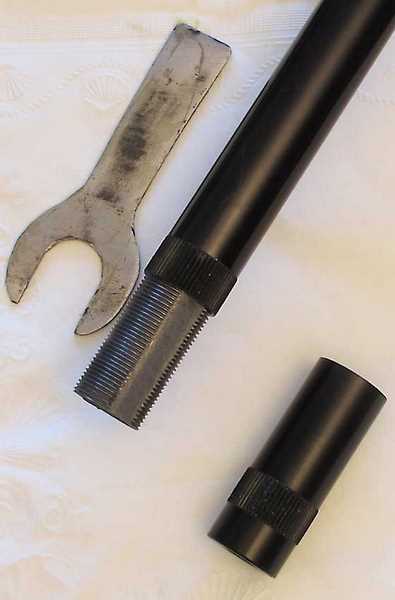
Here you see the HOTS mechanism. The threaded weight is turned in or out of the barrel jacket by the wrench. Once the weight is where you want it, lock it down with the knurled collar on the barrel jacket. Then, install the long cap, and the job is done.
Where to start?
The problem is always the same: Where do you start adjusting the weight? The simplest way is to start right where you are — with the HOTS in the last position it was set. Shoot a group at that setting and go from there. I had that data, of course, from the earlier part of this test, so that’s where I began. Because the last transfer port is still installed in the rifle, the Beeman Devastator pellet still develops about 772 f.p.s.
When I shot a group at this velocity in the earlier test, 10 shots went into a group measuring 1.073 inches between centers. I was looking for a group somewhere near that size this time, too. It might be a little smaller or larger; but if it was a quarter-inch group, there was a problem with the results of the last test. The same care was taken with each shot; to do any less would have skewed the results or made them unreliable at the very least.
The first group shot in this test, shot with the same HOTS setting, measured 0.953 inches between centers. That’s 0.12 inches smaller than the group from the last test. I would call that in the same ballpark and therefore a confirmation that the last test was sound.
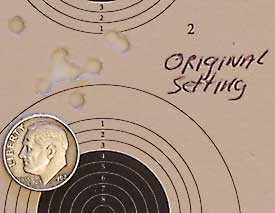
Ten Beeman Devastators at 25 yards went into this 0.953-inch group with the original HOTS setting. It’s close to what the gun did in the last test on the same setting.
Adjusting the HOTS
Whiscombe says that there will be several sweet spots throughout a one-inch movement of the weight, which is approximately 25 full turns. He also says that one spot will be better than the others, and that’s the one to look for. He just doesn’t tell you how to find it, other than by adjusting the weight one turn at a time. But my experience told me that the sweet spot was probably not where the weight was at this time, so I turned it in (toward the receiver of the gun) four full turns and shot a second group. This is where my experience with the Whiscombe was supposed to pay off.
I wasn’t going to waste my time shooting 10 shots if the first 5 were spread out. Why bother? I wanted a tight group, and if inside 3-4 shots — or even 2, on one occasion — there was already a large separation, it was no use going further. I turned the weight in 4 full turns and shot another group. This group teased me with the first 5 shots in less than a quarter-inch, but the final 5 expanded that to 0.977 inches. Can’t be certain because of measurement errors, but no improvement at all.
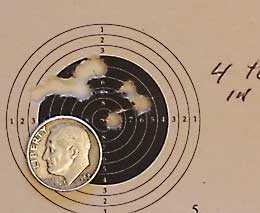
At 0.977 inches, this group is slightly larger than the original setting. Obviously, the HOTS isn’t adjusted at this spot.
Next, I tried the weight 5 turns in from the start point. The group was worse. I backed out to 3 turns in and got about the same size group as with 4 turns in.
At this point, I experimented with some subtle adjustments on a half and then a quarter turn. At 3.5 turns in, I got a group that was slightly smaller than the one at 4 turns, but it had one called flyer. I tried another quarter turn in and got 4 shots in a group measuring 0.998 inches between centers. Obviously, I wasn’t going the right way.
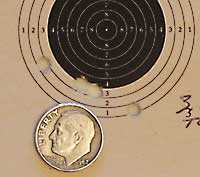
No sense finishing this group. Four shots are already grouping 0.998 inches.
Okay, this wasn’t working. I adjusted the weight out in the other direction 9 full turns past the initial setting and shot another group of 10. This time there was some success, as the group measured 0.794 inches between centers. I wanted to call that the end of the test; but looking at the group, I knew it wasn’t enough of a difference to impress anyone. Even though it does show improvement over the baseline group, I would like to show a larger change since one of the Devastator groups in the earlier tests measured 0.616 inches. This group was too much larger than that. The gun should be able to do better if harmonics and not velocity was the main driving force behind accuracy.
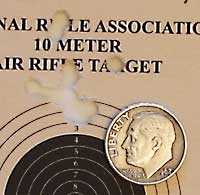
This group is better than the baseline group, but it’s not as good as some groups that were fired in the big test. It measures 0.794 inches between centers.
By this time, I’d fired 49 shots in about 90 minutes. The test work had lasted much longer than expected, and I had to quit for the day.
A happy accident
The next morning, I was back at the bench and trying to complete the work. I figured I would adjust the weight out from the initial setting by a certain amount but as I tried to do that a happy accident happened. The front cover got stuck together with the weight; and by the time I noticed it, I’d already adjusted it 15-20 turns. Except, I had no way of knowing how many turns it was. I had to start all over, and this time from a random place that bore no known relation to the initial start point. Not that it mattered, except I didn’t want to waste all of the work from the day before.
I adjusted the weight at a point that looked to be well away from the initial setting. Then, I shot a group as a baseline. Or I should say I began to shoot a group. After 3 shots, I had a spread of 1.153 inches between centers — the largest spread of the entire test to this point. No sense finishing that one!
Past experience has shown that the sweet spots are often a couple turns in either direction. I guessed and turned the weight back in three turns from the starting point. And that was when it happened. The clouds rolled back, the angles sang and the rifle grouped like I knew it could. Ten shots went into 0.523 inches. That’s not only the best group of this little experiment with the HOTS, it also beats every group fired with the rifle during the main test conducted earlier.
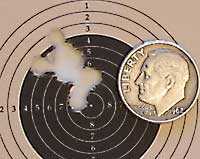
This group of 10 was shot on the second day, with 3 turns in from the start point. It measures 0.523 inches and proves that the Beeman Devastator can shoot accurately at 772 f.p.s.
The results
With this kind of data in hand, I can say with some confidence that harmonics and not velocity is the main driver in how accurate a spring gun can be. I say this because the worst group shot during the velocity test was adjusted harmonically into the best group of the test with this pellet. There’s no chance in this group — it’s clearly much better than it was in the beginning.
Could the rifle shoot this pellet even better? Maybe. But it isn’t necessary to prove the point we were trying to prove.
Next, I want to adjust the rifle for Beeman Kodiaks at a higher velocity and test pellets straight from the tin against pellets that are sorted by weight. Today’s report should give everyone the confidence that, if a difference in accuracy is noted, it will be because of the pellets and not the gun.

Hoping for your swift and uneventful recovery!
Chris,
I still can’t see very well and with a patch over the eye I can’t wear reading glasses. Hard to see things people are writing to me.
B.B.
Hoping the eye is doing well and recovery will be speedy. I love the Wiscombe articles. I real tinkerer’s dream with all of the infinite combinations of adjustments available. For those that like to crunch numbers and analyze data,.. this would be an ideal project.
Good Day all,…. Chris
BB,
This should keep us busy for a while.
I pray that all goes well. I look forward to seeing you some time.
BB
Praying all is well with your eye.
Best of luck with the second eye surgery and recovery.
Just a quick FYI in regards to cataract surgery which I had last November. I have noticed over the past few weeks that I am not seeing as well as previously with a halo or “ghosting” when I stare at objects or when I am driving. I made a follow-up appointment next Monday. My research has uncovered that it is very common for a film to appear over the lens replaced after the cataract surgery. A 15 minute procedure using a laser solves the problem. A common problem and an easy solution. Just be aware that down the road you may have another issue.
Bob
Bob,
Thank you for that. The eye doctor who did the surgery is also my regular eye doctor, so she will keep an eye on it. I go in to an aftewr-surgery exam this morning.
B.B.
B.B.,
Get well soon.
Regarding harmonics, I have tried and tried to understand what it is regarding shooting. I know what harmonics is when it comes to sound and timbre. What is/are harmonics as it/they pertain[s] to an air rifle?
And, shy of using a Whiscomb, how does one affect them to improve accuracy?
Michael
Michael,
Harmonics in an airgun are vibrations you can’t hear. They are identical to the vibrations of a guitar string.
How you can affect them is by adjusting your artillery hold. Where the off hand is will change the point where the pellet leaves the muzzle, because it changes how the muzzle moves as it vibrates. Changing pellets chances velocity and also changes how harmonics affect the shot. And tuning the rifle will also change the harmonics.
B.B.
B.B.;
B.B.,
O.K. That makes sense.
Having the off-hand as close to the trigger guard as possible often improves accuracy, and it seems to me that moving the fulcrum farther back allows the muzzle to “do its thing” as well as making the rifle muzzle heavy, which also usually improves accuracy by reducing muzzle movement. And a quick lock time plus shorter barrel helps to get the pellet clear of the muzzle before some of the vibration begins.
I imagine the pellet used would also have an effect on harmonics. With springers you test you often comment how a rifle feels when it shoots one pellet versus another, with weight being the biggest factor in the difference.
Michael
Michael
Also pcp guns, pump guns, Co2 and firearms. They all have their own type of vibrations.
Hey GF1′
Posted some new dope on the Wildfire on yesterday’s Blog. Wasn’t sure if you would look back on it so I’m mentioning it here.
Halfstep
Going to read it in just a second. I will reply over on yesterday’s blog in a minute.
Michael,
Re: “And, shy of using a Whiscomb, how does one affect them to improve accuracy?”
In addition to adjusting your hold on a gun to counter the affects of harmonics in a gun in order to improve accuracy there are devices similar to the Whiscombe HOTS system.
Think of the Browning BOSS system. There are also aftermarket deresonators that can be purchased. Some of them are inexpensive like the ones made by limbsaver.
Michael,
My understanding is the barrel whip that can be seen in slow motion video of a firearm rifle. The idea is to affect that whip so that barrel is in relaxed state/position ( 0 tension ) AND timing that with the projectile leaving the barrel. Moving the barrel band back on my Maximus improved the accuracy. I moved it about 3-4″. Thanks to Gunfun for that idea. Of course with airguns, that barrel whip is much less pronounced.
BB,
Since this isn’t your first rodeo with cataract surgery you know the drill, lol. A heavy dose of patience to let it heal properly along with all those eye drops and soon this eye will be as good or better than the other. Keeping both fingers crossed that you end up with vision to rival an eagle!
My rail lock compressor from PA arrived yesterday and following your helpful hints I was able to easily and successfully disassemble my R1 Laser without issue. It is a simple and minimalistic alternative to a normal spring compressor. I’ll be interested to see how the reassembly goes. Can’t wait to see how much fiddling is required to get the end cap threads lined up correctly. Your report on the Beeman R8 has been very timely. Thank you and best wishes for a speedy recovery. Regards, Jim H.
B.B.
Wishing you a speedy recovery. Prayers are sent your way.
Ken
BB
I believe you will be pleased with your surgery outcomes. I’m praying that will be the case.
Love this report! Plus there are 10 more parts. The endless combination of variables affecting accuracy is what motivates me. Since I flipped over to the bright side a few years ago to airguns from firearms I can play everyday.
BB
Hi BB, prayers for your quick recovery! So that makes both eye with 20/20 vision! That’s exciting!
Regards,
Peter
I thought you just had cataract surgery. Perhaps you only did one eye. Anyway, this is a high-percentage procedure, unlike some of the others, so the outlook is good.
On the subject of accuracy, I was reading about the army’s new designated marksman rifle which is based on the HK417. In other words, an AR design with a G36 style piston which in turn is a close copy of the Armalite 18 design of Eugene Stoner. So, the army is finally getting what it should have gotten in the Vietnam War. The direct gas impingement has its points, but I’m a believer in pistons, myself. Anyway, each of these rifles is supposed to cost $12,000, and for all that, the accuracy requirement is 1.5 MOA at 100 yards with 10 shots using target ammo loaded with Sierra Match King bullets. If memory serves, a 10 shot group of that size is comparable to a 5 shot group of about 80% of the size which is still greater than MOA. That doesn’t seem like much of a return for $12,000.
Gunfun1, right you are about the vagaries of practice and skill. Last weekend, I had a truly abominable knife throwing session where I missed just about every single throw. But then, I went out after months of no practice and was able to hit my goliath sized target with a sling at 20 yards several times. Calculating the accuracy was a hoot. As I retrieved the rocks afterwards, my rough spread was about 10 yards wide.
Gunfun1, I remember that you were knowledgeable about cars, but I didn’t grasp the full extent of your involvement. I like the idea of a sleeper car very much. This is equivalent to Teddy Roosevelt’s advice to walk softly and carry a big stick. I also am not too enamored of current designs of sports cars. I got my first ride in a Chevy Camaro recently and had mixed feelings. On the one hand, it felt like a spaceship inside. On the other hand, I had trouble seeing out of it. I felt like I was in a tank. What kind of models did you renovate as sleeper cars and how did you do it? Did you just put a bigger engine in?
In other news, my re-enactment interests have advanced further with the acquisition of a reproduction German trench knife by Boker. I was first attracted to it by reading that, like Ballistol, it was used by the Germans in both world wars, so it had to be good. One commentator has described it as the perfect compromise between the Kabar, which is a little too robust, and the Sykes-Fairbairn knife which is too delicate. In the hand, this knife feels wicked, I must say. The only one that felt moreso is my Roman gladius which is so vicious that it looked like it was cutting the air while lying on a table. But this new blade is a significant achievement. German engineering brings it home again.
Matt61
Medicare will only pay if you have cataract surgery one eye at a time. Do two at once and the procedure is on your dime. Maybe it has to do with the concept that if the first one has a problem, at least you still have one good eye??? The two procedures are several weeks apart as it takes a while for one eye to normalize after being operated on.
Matt61,
There are more 400+ horsepower cars available now than at any point in YOUR lifetime. If you want to go around corners, get a Chaterham.
-Y
Matt61
I had a really good pyhs. ed. teacher in 9th and 10th grade. He definitely knew how to push us and make us get somewhere. Always what he said was practice, practice, practice. And he always come back and say see it did make you better. He would not take no I can’t do that for a answer. He made you try. And it did make you want to try more when you seen the results. I find myself saying it to my daughter’s all the time. Even at work to the young guys just starting in the machine shop world.
And yep always my favorite thing was to see a car at the dragstrip that looked no kind of way or even sounded like it was fast just blowing away the other cars down the track. There was a old brown faded out 4 door 76 Nova and rust on the fenders. Front left fender was crunched and the head light was gone. Had faded black steel rims with no hub caps. When the car left the line it would twist over to the right and pull the front tires of the ground about a foot for 2 car lengths. He would never open the hood so you never saw his engine and it was dual exhaust but quiet as can be. Oh but I did notice the reason why his headlight was missing on the crashed fender. He had a big 6″ air ducting in it that I’m sure that ran to the air cleaner on the carb. Yep a ram air induction. So that headlight missing was a functional part of the sleeper act. I later found out the gas tank was filled with and and water for weight ballas behind the rear tires. And he had a 6 gallon fuel cell in the trunk. So that helped him hook up and transfer the power to the ground with regular ole radial tires. They weren’t even soft compound cheater slicks. So yep that was my kind of car.
But I had a bunch of muscle cars from the 60’s and 70’s that was real nice. They looked like they just came off the new car showroom floor. But had all the engine and chassis and suspension speed tricks done to them. Yes they would pull the front wheels and look like not a thing was done to them exterior or interior wise. But had all the go fast goodies done in all the right places.
Oh and I think pretty much what you said about the new Camaro’s. I’m a Camaro person but I sure don’t like that new body style at all. I like a 1990 Camaro or a 1970 to 73 Camaro being my top choice. Then the 90 body style. Never was even crazy about the 1967- 69 Camaro’s. That’s what year Camaro the tried to go off of when they designed the new body style. Now look at the new Dodge Challenger. Those I like. And the new Mustang body style is ok too.
But if somebody gave me a new Camaro I would take it. 🙂
Bad day to ask a question I guess. Tom can’t see… So everyone out there tell me what is the best base/scope option for an RWS/Diana 350 Magnum with the TO6 trigger? I have an old RWS lockdown mount and a Meopta Meopro 6-18X50 on there now but it is a $600 scope that doesn’t adjust less than 50 yards and it is about to be mounted on a Winchester Model 70 .223… any open sight people out there using peep sights? I’d love to hear from anyone and everyone. Does Leapers make one for the 350 with the new trigger? I want the lowest option those Weaver/Picatinny rails always seem to be 3/4″ off the barrel even with a 50mm scope.
B.B.,
I also hope your eye will be better soon.
I don’t know about “new year”, but I took a moment to look and I see that it is May again. I pray that you feel all that you feel and that it doesn’t keep you from your appointed rounds. Your cats need you (and we do as well).
Here is something interesting. It is co2 powered, accurate to 150 feet, and looks like a semi-auto caricature of a commando/swat pistol. It is offered as a non-lethal self defense weapon. I think I would get one and have it on me lest I become suicidal at a moments notice.
http://www.getdatgadget.com/pepper-spray-gun-self-defence-safe-distance/
~ken
Ken
That’s interesting and different. I book marked the link.
Hope the surgery went well.My prayers and best wishes to you.
BB,
Did you ever tune the HOTS for the Kodiacs ? I tried searching for it but didn’t have any luck. Also, I’d like to know what you think the Devastators would have done with the largest limiter plug installed after the HOTS tune. Get healed up and hope you get good results with this eye also.
Halfstep,
No. As I said inn the intro, this report is the last in the series.
B.B.
BB
But at the end of Part 11 you wrote ” Next, I want to adjust the rifle for Beeman Kodiaks at a higher velocity and test pellets straight from the tin against pellets that are sorted by weight. Today’s report should give everyone the confidence that, if a difference in accuracy is noted, it will be because of the pellets and not the gun.” Did you ever do that? And again I’ll ask if you have an opinion on how the Devastators would have performed at higher velocity out of the HOTS adjusted gun. Do you think the accuracy would have diminished from the first string of shots at the beginning of the test or do you think that the newfound accuracy would have carried over to the higher velocity ?
How is your peeper doin’? Does the lens replacement leave you with 20/20 vision as well as a clear field of view or were you 20/20 already but foggy because of the cataracts.
Halfstep,
I know what I said. That’s why I wrote what I wrote. I’m done with that test.
The test you want to see is in Part 10.
My eye is doing great. It gets better by the hour. It was 20/25 before the operation, but getting cloudier fast.
B.B.
Regarding the Salt Gun, here is a YouTube video that is still available. Interesting review (and more professional than a lot of them). He states the Salt Gun is intended for indoor use, where factors like wind don’t exist. I suppose the “accurate to 150 feet” is to say that it is accurate at normal indoor ranges.
https://www.youtube.com/watch?v=JSJ2eWarVmY
~ken
Ken
Seems to be pretty accurate. A little on the expensive side. And the 4 year shelf life of the ammo is not bad.
BB
I am seeing more successful cataract surgery today then ever before. It seems such an operation has become routine rather then the exception. I wish all the best to you during your recovery. I trust you will obtain the results you desire in the years ahead.
Ciao
Titus
B.B.
Wishing you a speedy and 110% recovery. Same doctor, same patient, should get the same result.
Now you can try alternate hand shooting! LOL.
Barrel harmonics? Are we trying to eliminate/reduce the barrel oscillation or just have it repeatable? The only way to really test the HOTS system is to start at one range of full adjustment and shoot targets every 4 turns until you are at the other full range of adjustment. Then score your targets!
Wouldn’t multiple barrel weights, thicker barrels, barrel shroud all help? Are these oscillations long frequency short duration? You need an oscilloscope!
Heal well,
Yogi
Yogi,
The barrel harmonics can’t be eliminated by any practical means. We are trying to make them repeatable.
B.B.
That Salt tear gas pistol is a rebranded Tipman paint pall pistol priced about a hundred dollars more. Paint ball sized ammo and RAP 4 offers a similar irritant filled paint ball that is also cheaper.
You can read reviews about the pistol above on Amazon